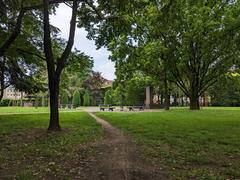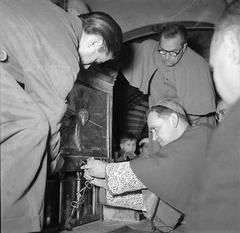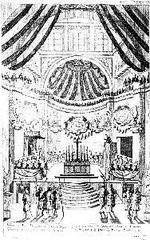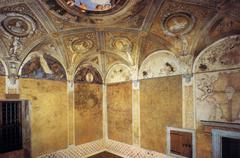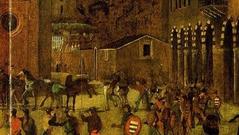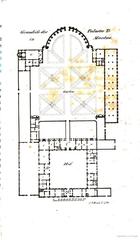Santa Maria della Vittoria Mantua: Visiting Hours, Tickets, and Historical Sites Guide
Date: 04/07/2025
Introduction
Santa Maria della Vittoria in Mantua, Italy, is a compelling monument that encapsulates the city’s Renaissance artistry, religious fervor, and complex socio-political history. Founded in 1496 by Francesco II Gonzaga in gratitude for victory at the Battle of Fornovo, the church is both a testament to dynastic ambition and a reminder of the intertwined narratives of faith, art, and power in Renaissance Lombardy (Mantua Tourism). Notable for its blend of late Gothic and early Renaissance architecture and its original housing of Andrea Mantegna’s “Madonna della Vittoria” (now in the Louvre), the site remains a pivotal point of interest for visitors exploring Mantua’s UNESCO-listed center (Fondo Ambiente; Louvre Museum).
This detailed guide covers the church’s historical context, artistic significance, practical visitor information (including visiting hours and accessibility), and suggested itineraries for a rewarding visit.
Table of Contents
- Introduction
- Historical Background
- Artistic and Iconographic Significance
- Interfaith Relations and Social Impact
- Liturgical and Community Life
- Visitor Information
- Architectural and Artistic Highlights
- Events and Cultural Programming
- Visitor Experience
- Visual and Interactive Resources
- Frequently Asked Questions (FAQ)
- Conclusion and Call to Action
- References and Further Reading
Historical Background
Foundation and Origins
Santa Maria della Vittoria was commissioned by Francesco II Gonzaga after his victory at the Battle of Fornovo in 1495. The church’s name—“Saint Mary of Victory”—commemorates this triumph and expresses the deep Marian devotion of the Gonzaga dynasty (Mantua Tourism). Construction began in 1496, with the church soon rising near Mantua’s medieval walls as both a votive offering and a symbol of Gonzaga authority.
However, the church’s founding was marked by a tragic episode involving the Jewish da Norsa family, whose home was seized and demolished after religious unrest erupted over their removal of a Madonna fresco. This act of confiscation, sanctioned by the authorities, underlined the socio-religious tensions of Renaissance Mantua (aish.com; visitjewishitaly.it).
Architecture and Artistic Heritage
Santa Maria della Vittoria is a late Gothic single-nave building with early Renaissance elements, designed by Bernardino Ghisolfi. The façade features pointed arches and a rose window, while inside, the nave is flanked by side chapels and topped by a vaulted ceiling adorned with frescoes and stucco work (Fondo Ambiente). The church originally housed Mantegna’s “Madonna della Vittoria,” a masterwork blending sacred and dynastic imagery—a key example of art serving both devotional and political ends (Google Arts & Culture). The original altarpiece was seized by Napoleonic troops in 1797 and now resides in the Louvre (Louvre Museum; Wikipedia).
Restoration efforts have preserved the church’s architectural integrity, revealing historic features such as faux Cordovan leather wall coverings, decorative pilasters, and late 15th-century frescoes inspired by Mantegna (Italia-Italy).
Social and Religious Context
The church’s creation was not merely a religious gesture but also a political maneuver. It reinforced the Gonzaga family’s legitimacy and Christian dominance in Mantua. Its construction over the da Norsa home symbolized the assertion of Christian authority and the marginalization of the city’s Jewish community (aish.com).
Artistic and Iconographic Significance
The Madonna della Vittoria Altarpiece
Andrea Mantegna’s “Madonna della Vittoria” (1496–1499) was the church’s original artistic centerpiece. Commissioned as part of the da Norsa family’s penance, the painting depicts Francesco Gonzaga kneeling before the Madonna and Child, surrounded by saints and sorrowful da Norsa family members marked with yellow badges (aish.com). The Latin inscription “debellata iudeorum temeritate” (“the audacity of the Jews vanquished”) underscores the propagandistic use of religious art in the service of power (visitjewishitaly.it).
Although the original is now in Paris, interpretive panels and reproductions in the church provide historical context.
Religious Art as Power
Santa Maria della Vittoria’s artistic program exemplifies how Renaissance churches functioned as tools of both worship and propaganda, glorifying patrons while reinforcing social hierarchies (aish.com).
Interfaith Relations and Social Impact
The church’s story is inseparable from Mantua’s Jewish history. The forced demolition of the da Norsa home and the denigrating depiction of the family in Mantegna’s painting reflect broader trends of religious intolerance and social control in 15th-century Italy (aish.com). Today, the site serves as a focal point for reflection, dialogue, and remembrance, with educational initiatives promoting interfaith understanding (visitjewishitaly.it).
Liturgical and Community Life
Santa Maria della Vittoria remains an active place of worship and cultural gathering. It hosts liturgical ceremonies, community events, and is a locus of Marian devotion. The church also plays a role in local festivals, including the renowned Festivaletteratura, which brings Mantua’s history and culture to life (Festivaletteratura; in-lombardia.it).
Visitor Information
Visiting Hours
- Monday to Saturday: 9:00 AM – 6:00 PM
- Sunday and Public Holidays: 10:00 AM – 5:00 PM
Note: Hours may vary for holidays or special events. Always check with the Mantua Tourism Office or Festivaletteratura for the latest updates.
Tickets and Accessibility
- Admission: Free; donations are encouraged to support preservation (WhichMuseum).
- Accessibility: The ground floor is accessible for visitors with reduced mobility. Upper levels may require stairs; contact the venue in advance for specific needs (Italia-Italy).
Guided Tours and Facilities
- Guided Tours: Available through local tourism offices or during festivals. Advance booking is recommended.
- Facilities: No restrooms or cloakrooms; cafés and amenities are nearby in Mantua’s city center.
Architectural and Artistic Highlights
- Façade: Modest brickwork with pointed Gothic arches and a rose window.
- Interior: Single nave, side chapels, vaulted ceiling, and restored late 15th-century frescoes inspired by Mantegna.
- Artworks: Commemorative canvas and interpretive panels recount the story of the original “Madonna della Vittoria.” Faux Cordovan leather walls and decorative pilasters add to the period atmosphere (Google Arts & Culture).
Events and Cultural Programming
Santa Maria della Vittoria is a vibrant cultural venue, hosting temporary exhibitions, concerts, and lectures. During Festivaletteratura, the church becomes a hub for literary and artistic events, attracting visitors from around the world (Festivaletteratura; Finestre sull’Arte).
Visitor Experience
Location and Getting There
- Address: Via Claudio Monteverdi 1, Mantua (Italia-Italy)
- Access: Short walk from Piazza Sordello, Palazzo Ducale, and other historic sites. Mantua’s city center is compact and pedestrian-friendly (TravelConnectExperience).
Nearby Attractions and Itineraries
Recommended sites within walking distance include:
- Palazzo Ducale
- Basilica di Sant’Andrea
- Palazzo d’Arco
- Mantegna House
- Castello di San Giorgio
A suggested itinerary: morning at Santa Maria della Vittoria, stroll through medieval streets, local lunch, and afternoon exploring Mantua’s palaces and museums.
Local Gastronomy
After your visit, enjoy Mantuan specialties such as pumpkin tortelli, risotto alla pilota, and torta sbrisolona at nearby restaurants (Finestre sull’Arte).
Safety and Etiquette
Mantua is safe and visitor-friendly. Dress modestly when visiting the church (shoulders and knees covered), maintain a respectful quiet, and avoid flash photography during services or near delicate artworks.
Visual and Interactive Resources
- Virtual Tour and Images: Explore high-quality images and an immersive virtual tour on Google Arts & Culture.
- Interactive Map: Plan your walking route with digital maps of Mantua’s historical center.
Frequently Asked Questions (FAQ)
Q: Are tickets required to enter?
A: Admission is free; donations are appreciated.
Q: What are the opening hours?
A: Generally open daily (except Mondays), 9:00 AM – 6:00 PM. Check ahead for variations.
Q: Is the church accessible for visitors with disabilities?
A: The ground floor is accessible; upper levels may not be. Contact the venue for details.
Q: Are guided tours available?
A: Yes, especially during festivals and by local associations.
Q: Can I take photographs inside?
A: Photography is allowed, but avoid flash and be respectful during services.
Conclusion and Call to Action
Santa Maria della Vittoria is an essential stop for anyone seeking to understand Mantua’s Renaissance legacy, artistic treasures, and historical complexity. Its central location, free admission, and rich programming make it accessible to all visitors. For the latest visiting hours, event details, and guided tour options, consult official tourism sources.
Enhance your experience by downloading the Audiala app for self-guided audio tours of Mantua’s historical sites. Follow us on social media for event updates, exclusive content, and expert tips.
Begin your journey into Mantua’s Renaissance heritage with Santa Maria della Vittoria—where art, faith, and history converge.
References and Further Reading
- Mantua Tourism
- Fondo Ambiente
- Louvre Museum
- aish.com
- visitjewishitaly.it
- Festivaletteratura
- Italia.it
- Google Arts & Culture
- TravelConnectExperience
- WhichMuseum
- Italia-Italy
- Finestre sull’Arte
- Wikipedia
- in-lombardia.it

